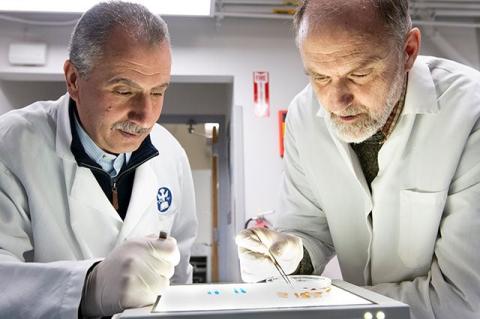Molecular Helminthology Laboratory
The Molecular Helminthology Laboratory at Cummings School of Veterinary Medicine at Tufts University is run by Dr. Patrick Skelly in collaboration with Dr. Charles Shoemaker. The laboratory exploits modern molecular biology tools to investigate, primarily, the interaction of helminth parasites with their hosts, and is currently engaged in a variety of projects involving worms of medical and veterinary importance that belong primarily to the phylum Platyhelminthes.
Schistosomes Project
Schistosomes, a genus of trematodes, currently infect several hundred million people globally. The World Health Organization estimates that hundreds of thousands of people die of schistosomiasis each year and about a billion people are at risk of exposure. Schistosomes also infect livestock and cause serious economic hardship in many third-world nations. The disease is characterized by the presence of adult worms, or blood flukes, within the host's vascular system. These worms, living as male-female pairs, can survive for many years during which time the female produces hundreds of eggs per day. The primary damage caused by schistosome infection arises from the host's immune response to parasite eggs within host tissues. For more information on schistosomiasis, please see the CDC Schistosomiasis page.
The Molecular Helminthology Laboratory principally studies the host-parasite interface with the goal of better understanding how these remarkable worms can thrive within immune-competent mammalian hosts for years, even decades. It is anticipated that this knowledge will contribute to new ways to prevent and treat blood fluke diseases.
For more information about the Molecular Helminthology Laboratory's research with this model species please see the Schistosome Project.
Two Cummings School researchers studying schistosomiasis find molecules that may hold the key to a cure
A handful of labs in the world, including one at Tufts’ veterinary school, hunt for a cure for a debilitating parasitic infection that afflicts over 200 million people
Laboratory Personnel
- Sreemoyee Acharya
- Akram Da’darah
- Roshni Gondane
- Catherine Nation
- David Pirovich
- Charles Shoemaker
- Patrick Skelly
- Jacque Tremblay
Contact

Charles Shoemaker
Ph.D.
My overall scientific goal is to continue contributing research outcomes that lead to improved prevention and therapy of animal and human diseases. Since 2004 at Tufts, my lab has primarily performed research to develop therapeutic agents that prevent or reverse intoxication from bacterial toxins. This work initiated with a focus on botulinum neurotoxin but has expanded to Shiga toxins, C. difficile toxins, anthrax and ricin. We are also developing VHH-based therapeutics to treat enteric pathogens such as Shigella, Cryptosporidia and Enterotoxigenic E. coli. In related work, we are developing immunotheraputics for prevention or treatment of the developing world disease, schistosomiasis. Our major current collaborations are with other Tufts laboratories and laboratories at U. Cal. Irvine (UCI), NY University (NYU), Wake Forest Institute for Regenerative Medicine, UMass, Northeastern U., Harvard U., Wadsworth Institute, and HDT Bio. Much of our research involves the lab's expertise in the preparation and engineering of immunotherapeutics composed of camelid single-domain antibody binding agents called VHHs or nanobodies. We have leveraged this expertise to attract numerous funded collaborations in which we assist other labs or companies in the production and engineering of these binding agents for their projects. Prior to joining Tufts and since 1987, most research under my direction applied molecular biology tools to the study of host interactions with helminth parasites, and this work continues to a lesser extent.




